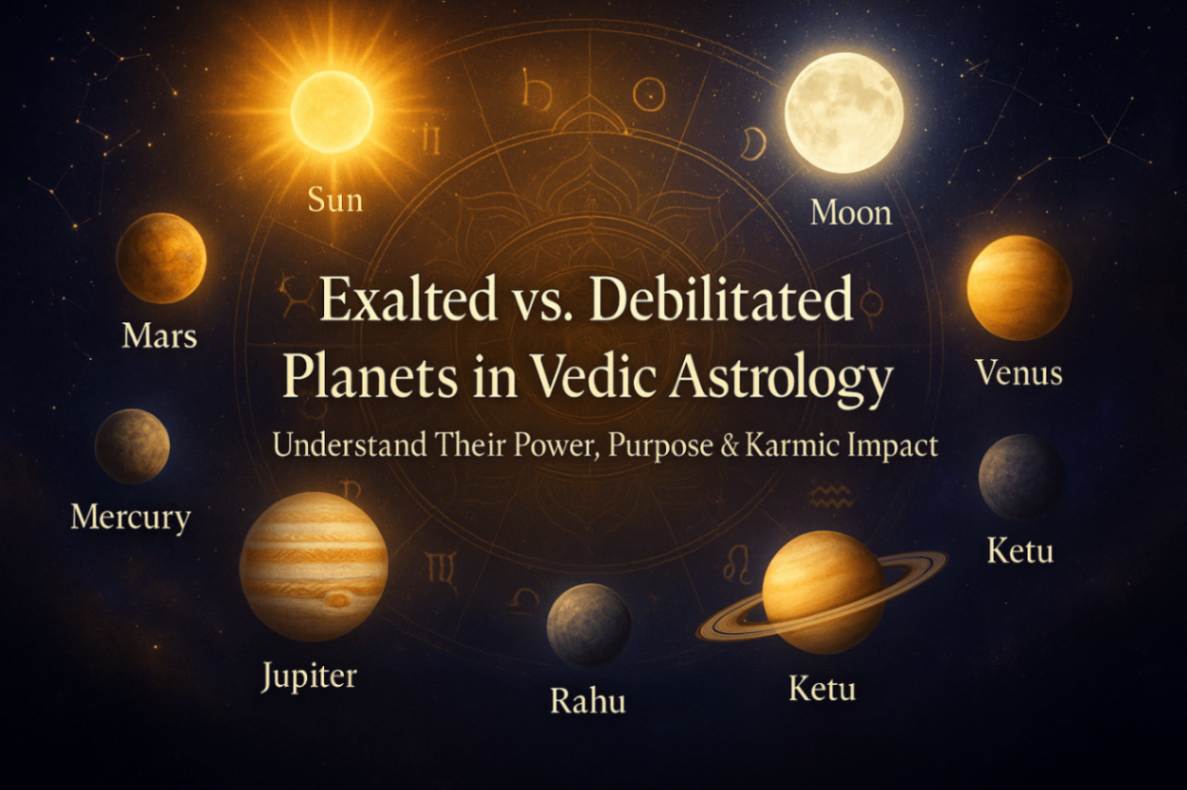A Practical Vedic Astrology Guide to Vedic Vedic Nakshatras, Sub-Layers, and Divisional Charts
Introduction
Vedic astrology offers a vast toolkit—planets, signs, houses, aspects, yogas, nakshatras, dashas, transits, and divisional charts. Many students learn these basics but struggle to use them together with precision.
This guide presents a hands-on method that unites nakshatras and divisional charts (vargas). By exploring star sub-layers and micro-divisions, you’ll see how small birth-time shifts can alter life outcomes. The goal is to simplify complex ideas, honor classical wisdom, and give you clear rules you can apply today.
Why Charts Fail Without Nakshatras and Vargas
The Rashi chart (D1) shows the broad life map.
But Vedic astrology is stellar—every planet sits in a nakshatra and pada, carrying the flavor of its star-lord.
Vargas refine the Rashi chart into specific life areas like marriage, career, children, and spirituality.
If you rely only on the D1 chart, you’ll miss events. Accurate prediction demands a three-fold approach:
Rashi chart for themes.
Nakshatra sub-layers for triggers.
Vargas for topic-specific outcomes.
This framework separates similar charts into very different lives and helps time events within days, not years.
Core Building Blocks of Vedic Astrology
The Nine Planets (Grahas)
Sun (Surya): Soul, vitality, authority.
Moon (Chandra): Mind, emotion, mother.
Mars (Mangala): Energy, courage, conflict.
Mercury (Budha): Intellect, speech, analysis.
Jupiter (Guru): Wisdom, dharma, growth.
Venus (Shukra): Relationships, art, harmony.
Saturn (Shani): Duty, delay, karma, endurance.
Rahu: Obsessions, innovation, foreign links.
Ketu: Detachment, spirituality, karmic breaks.
The Twelve Houses (Bhavas)
Each house reflects a life sphere—1st (self), 5th (children), 7th (marriage), 10th (career), etc. Planets deliver results through both occupation and lordship.
Aspects (Drishti)
All planets aspect the 7th house.
Special aspects: Mars (4,8), Jupiter (5,9), Saturn (3,10).
Rahu/Ketu mimic Mars-Saturn influence.
Planetary Strength
Check dignity, combustion, retrogression, directional strength, and nakshatra lordship. Benefic aspects (e.g., Jupiter) protect, while malefics (Saturn, nodes) test and mature.
Nakshatras, Padas, and Sub-Layers
Nakshatras (27 stars × 4 padas) are the soul of timing. But deeper precision comes from micro-layers:
Star-lord (nakshatra lord).
Sub-lord (finer division).
Sub-sub lord (even finer).
These act like gears within gears. A few seconds’ difference in birth time can shift sub-layers and change outcomes—making rectification vital.
Hierarchy for timing:
Moon’s nakshatra → drives dashas.
Ascendant’s nakshatra → shapes events.
Fast movers (Moon, Mercury, Venus) → amplify micro-layer sensitivity.
Dashas and Transits: The Time Engine
Vimshottari dasha (120 years) is primary.
Each dasha lord reflects its house, sign, nakshatra, and varga strength.
Bhukti (sub-periods) refine results further.
Transits activate dasha promises (e.g., Venus or Jupiter transit triggers marriage).
Divisional Charts (Vargas): The Fine Focus
Key vargas include:
D9 Navamsha – marriage, dharma.
D10 Dasamsha – career, public life.
D7 Saptamsha – children, legacy.
D27 & D30 – inner strength and troubles.
D60 Shashtyamsha – karmic blueprint.
Workflow: Use D1 + topic-specific vargas + nakshatra micro-layers.
How to Use Vargas with Nakshatra Micro-Layers
Marriage & Partnerships (7th House)
Check 7th house, lord, Venus in D1 & D9.
Navamsha dignity + nakshatra micro-layers reveal marital stability or strain.
Nodes in sub-layers → sudden breaks.
Saturn → delays but long-term stability.
Children & Creativity (5th House)
Check 5th lord, Jupiter in D1 & D7.
Supportive sub-layers → easy conception.
Weak sub-layers → delays or medical intervention.
Career & Public Work (10th House)
Check 10th lord, Sun, Saturn, Mercury in D1 & D10.
Strong Mercury in D10 + good sub-layers → analysis, audits.
Saturn + Sun → structured/government roles.
Case Studies: Same Date, Different Lives
Case A – Auditor, Childlessness, Marital Strain
Mercury strong in D10 micro-layers → auditing career.
D9 shows 7th house affliction → marital strain.
D7 weak in sub-layers → childlessness.
Case B – Engineer, Government, Divorce, Foreign Move
Sun + Saturn in D10 → public sector/engineering.
D9 micro-layers of 7th lord → divorce.
D7 strong → two daughters.
Rahu links → relocation abroad.
Lesson: Place + time changes vargas and sub-layers → completely different lives.
Classical Guidelines to Remember
Moon anchors dasha system.
Vargas refine topic-specific truths.
Nodes mark breaks, separations, transformations.
Benefic aspects mitigate harm.
Practical Workflow for Astrologers
Start with D1 (Ascendant, lords, yogas).
Add D9/D10/D7 based on the query.
Record nakshatras of Moon, Ascendant, and topic lords.
Use dasha-bhukti + nakshatra sub-layers for timing.
Verify with transits.
Rectify if life events don’t align.
Ethics & Common Mistakes to Avoid
✅ Respect client free will.
✅ Use clear, supportive language.
❌ Don’t rely only on D1.
❌ Don’t skip rectification.
❌ Don’t ignore micro-layers.
Closing Thoughts
Vedic astrology is both art and science. The art lies in synthesis, the science in method. When you unite nakshatras, sub-layers, and vargas, you uncover a living map of destiny—one that refines timing, explains life differences, and builds confidence in prediction.
Key mantra:
Use the Moon for timing.
Vargas for detail.
Micro-layers for precision.
With humility and practice, this approach makes readings clear, accurate, and compassionate.


































